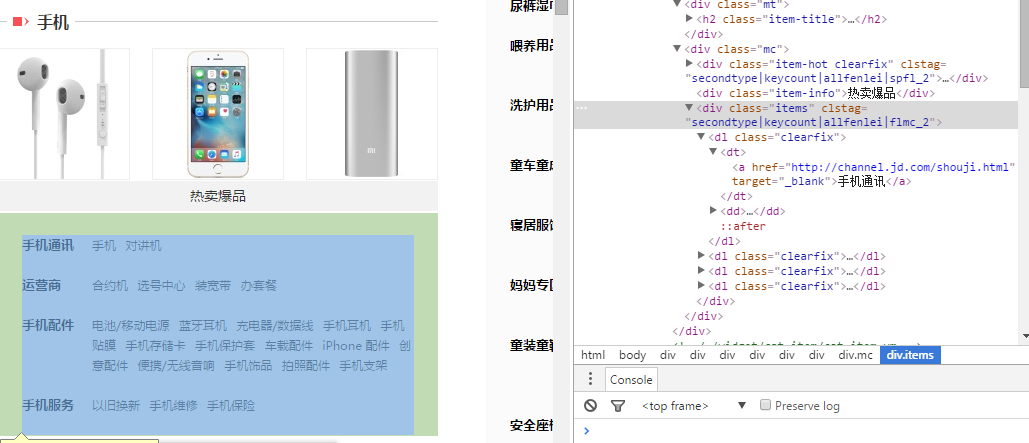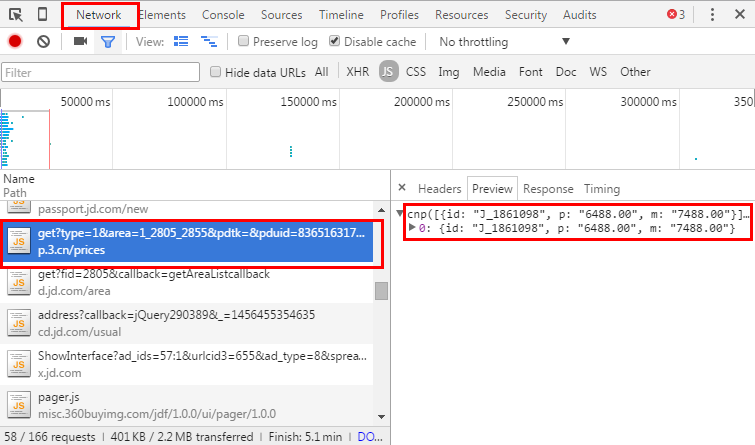教您使用java爬蟲gecco抓取JD全部商品資訊
轉自:http://www.geccocrawler.com/demo-jd/
gecco爬蟲
如果對gecco還沒有了解可以參看一下gecco的github首頁。gecco爬蟲十分的簡單易用,JD全部商品資訊的抓取9個類就能搞定。
JD網站的分析
要抓取JD網站的全部商品資訊,我們要先分析一下網站,京東網站可以大體分為三級,首頁上通過分類跳轉到商品列表頁,商品列表頁對每個商品有詳情頁。那麼我們通過找到所有分類就能逐個分類抓取商品資訊。
入口地址
新建開始頁面的HtmlBean類AllSort
- @Gecco(matchUrl="http://www.jd.com/allSort.aspx"
- public class AllSort implements HtmlBean {
- private static final long serialVersionUID = 665662335318691818L;
- @Request
- private HttpRequest request;
- //手機
- @HtmlField(cssPath=".category-items > div:nth-child(1) > div:nth-child(2) > div.mc > div.items > dl"
- private List<Category> mobile;
- //家用電器
- @HtmlField(cssPath=".category-items > div:nth-child(1) > div:nth-child(3) > div.mc > div.items > dl")
- private List<Category> domestic;
- public List<Category> getMobile() {
- return mobile;
- }
- public void setMobile
- this.mobile = mobile;
- }
- public List<Category> getDomestic() {
- return domestic;
- }
- public void setDomestic(List<Category> domestic) {
- this.domestic = domestic;
- }
- public HttpRequest getRequest() {
- return request;
- }
- public void setRequest(HttpRequest request) {
- this.request = request;
- }
- }
可以看到,這裡以抓取手機和家用電器兩個大類的商品資訊為例,可以看到每個大類都包含若干個子分類,用List\表示。gecco支援Bean的巢狀,可以很好的表達html頁面結構。Category表示子分類資訊內容,HrefBean是共用的連結Bean。
- public class Category implements HtmlBean {
- private static final long serialVersionUID = 3018760488621382659L;
- @Text
- @HtmlField(cssPath="dt a")
- private String parentName;
- @HtmlField(cssPath="dd a")
- private List<HrefBean> categorys;
- public String getParentName() {
- return parentName;
- }
- public void setParentName(String parentName) {
- this.parentName = parentName;
- }
- public List<HrefBean> getCategorys() {
- return categorys;
- }
- public void setCategorys(List<HrefBean> categorys) {
- this.categorys = categorys;
- }
- }
獲取頁面元素cssPath的小技巧
上面兩個類難點就在cssPath的獲取上,這裡介紹一些cssPath獲取的小技巧。用Chrome瀏覽器開啟需要抓取的網頁,按F12進入發者模式。選擇你要獲取的元素,如圖: 在瀏覽器右側選中該元素,滑鼠右鍵選擇Copy--Copy
selector,即可獲得該元素的cssPath
在瀏覽器右側選中該元素,滑鼠右鍵選擇Copy--Copy
selector,即可獲得該元素的cssPath
body > div:nth-child(5) > div.main-classify > div.list > div.category-items.clearfix > div:nth-child(1) > div:nth-child(2) > div.mc > div.items
如果你對jquery的selector有了解,另外我們只希望獲得dl元素,因此即可簡化為:
.category-items > div:nth-child(1) > div:nth-child(2) > div.mc > div.items > dl
編寫AllSort的業務處理類
完成對AllSort的注入後,我們需要對AllSort進行業務處理,這裡我們不做分類資訊持久化等處理,只對分類連結進行提取,進一步抓取商品列表資訊。看程式碼:
- @PipelineName("allSortPipeline")
- public class AllSortPipeline implements Pipeline<AllSort> {
- @Override
- public void process(AllSort allSort) {
- List<Category> categorys = allSort.getMobile();
- for(Category category : categorys) {
- List<HrefBean> hrefs = category.getCategorys();
- for(HrefBean href : hrefs) {
- String url = href.getUrl()+"&delivery=1&page=1&JL=4_10_0&go=0";
- HttpRequest currRequest = allSort.getRequest();
- SchedulerContext.into(currRequest.subRequest(url));
- }
- }
- }
- }
@PipelinName定義該pipeline的名稱,在AllSort的@Gecco註解裡進行關聯,這樣,gecco在抓取完並注入Bean後就會逐個呼叫@Gecco定義的pipeline了。為每個子連結增加"&delivery=1&page=1&JL=4100&go=0"的目的是隻抓取京東自營並且有貨的商品。SchedulerContext.into()方法是將待抓取的連結放入佇列中等待進一步抓取。
抓取商品列表資訊
AllSortPipeline已經將需要進一步抓取的商品列表資訊的連結提取出來了,可以看到連結的格式是:http://list.jd.com/list.html?cat=9987,653,659&delivery=1&JL=4100&go=0。因此我們建立商品列表的Bean——ProductList,程式碼如下:
- @Gecco(matchUrl="http://list.jd.com/list.html?cat={cat}&delivery={delivery}&page={page}&JL={JL}&go=0", pipelines={"consolePipeline", "productListPipeline"})
- public class ProductList implements HtmlBean {
- private static final long serialVersionUID = 4369792078959596706L;
- @Request
- private HttpRequest request;
- /**
- * 抓取列表項的詳細內容,包括titile,價格,詳情頁地址等
- */
- @HtmlField(cssPath="#plist .gl-item")
- private List<ProductBrief> details;
- /**
- * 獲得商品列表的當前頁
- */
- @Text
- @HtmlField(cssPath="#J_topPage > span > b")
- private int currPage;
- /**
- * 獲得商品列表的總頁數
- */
- @Text
- @HtmlField(cssPath="#J_topPage > span > i")
- private int totalPage;
- public List<ProductBrief> getDetails() {
- return details;
- }
- public void setDetails(List<ProductBrief> details) {
- this.details = details;
- }
- public int getCurrPage() {
- return currPage;
- }
- public void setCurrPage(int currPage) {
- this.currPage = currPage;
- }
- public int getTotalPage() {
- return totalPage;
- }
- public void setTotalPage(int totalPage) {
- this.totalPage = totalPage;
- }
- public HttpRequest getRequest() {
- return request;
- }
- public void setRequest(HttpRequest request) {
- this.request = request;
- }
- }
currPage和totalPage是頁面上的分頁資訊,為之後的分頁抓取提供支援。ProductBrief物件是商品的簡介,主要包括標題、預覽圖、詳情頁地址等。
- public class ProductBrief implements HtmlBean {
- private static final long serialVersionUID = -377053120283382723L;
- @Attr("data-sku")
- @HtmlField(cssPath=".j-sku-item")
- private String code;
- @Text
- @HtmlField(cssPath=".p-name> a > em")
- private String title;
- @Image({"data-lazy-img", "src"})
- @HtmlField(cssPath=".p-img > a > img")
- private String preview;
- @Href(click=true)
- @HtmlField(cssPath=".p-name > a")
- private String detailUrl;
- public String getTitle() {
- return title;
- }
- public void setTitle(String title) {
- this.title = title;
- }
- public String getPreview() {
- return preview;
- }
- public void setPreview(String preview) {
- this.preview = preview;
- }
- public String getDetailUrl() {
- return detailUrl;
- }
- public void setDetailUrl(String detailUrl) {
- this.detailUrl = detailUrl;
- }
- public String getCode() {
- return code;
- }
- public void setCode(String code) {
- this.code = code;
- }
- }
這裡需要說明一下@Href(click=true)的click屬性,click屬性形象的說明了,這個連結我們希望gecco繼續點選抓取。對於增加了click=true的連結,gecco會自動加入下載佇列中,不需要在手動呼叫SchedulerContext.into()增加。
編寫ProductList的業務邏輯
ProductList抓取完成後一般需要進行持久化,也就是將商品的基本資訊入庫,入庫的方式有很多種,這個例子並沒有介紹,gecco支援整合spring,可以利用spring進行pipeline的開發,大家可以參考gecco-spring這個專案。本例子是進行了控制檯輸出。ProductList的業務處理還有一個很重要的任務,就是對分頁的處理,列表頁通常都有很多頁,如果需要全部抓取,我們需要將下一頁的連結入抓取佇列。
- @PipelineName("productListPipeline")
- public class ProductListPipeline implements Pipeline<ProductList> {
- @Override
- public void process(ProductList productList) {
- HttpRequest currRequest = productList.getRequest();
- //下一頁繼續抓取
- int currPage = productList.getCurrPage();
- int nextPage = currPage + 1;
- int totalPage = productList.getTotalPage();
- if(nextPage <= totalPage) {
- String nextUrl = "";
- String currUrl = currRequest.getUrl();
- if(currUrl.indexOf("page=") != -1) {
- nextUrl = StringUtils.replaceOnce(currUrl, "page=" + currPage, "page=" + nextPage);
- } else {
- nextUrl = currUrl + "&" + "page=" + nextPage;
- }
- SchedulerContext.into(currRequest.subRequest(nextUrl));
- }
- }
- }
JD的列表頁通過page引數來指定頁碼,我們通過替換page引數達到分頁抓取的目的。至此,所有的商品的列表資訊都已經可以正常抓取了。
詳情頁抓取
- @Gecco(matchUrl="http://item.jd.com/{code}.html", pipelines="consolePipeline")
- public class ProductDetail implements HtmlBean {
- private static final long serialVersionUID = -377053120283382723L;
- /**
- * 商品程式碼
- */
- @RequestParameter
- private String code;
- /**
- * 標題
- */
- @Text
- @HtmlField(cssPath="#name > h1")
- private String title;
- /**
- * ajax獲取商品價格
- */
- @Ajax(url="http://p.3.cn/prices/get?skuIds=J_[code]")
- private JDPrice price;
- /**
- * 商品的推廣語
- */
- @Ajax(url="http://cd.jd.com/promotion/v2?skuId={code}&area=1_2805_2855_0&cat=737%2C794%2C798")
- private JDad jdAd;
- /*
- * 商品規格引數
- */
- @HtmlField(cssPath="#product-detail-2")
- private String detail;
- public JDPrice getPrice() {
- return price;
- }
- public void setPrice(JDPrice price) {
- this.price = price;
- }
- public String getTitle() {
- return title;
- }
- public void setTitle(String title) {
- this.title = title;
- }
- public JDad getJdAd() {
- return jdAd;
- }
- public void setJdAd(JDad jdAd) {
- this.jdAd = jdAd;
- }
- public String getDetail() {
- return detail;
- }
- public void setDetail(String detail) {
- this.detail = detail;
- }
- public String getCode() {
- return code;
- }
- public void setCode(String code) {
- this.code = code;
- }
- }
@RequestParameter可以獲取@Gecco裡定義的url變數{code}。
@Ajax是頁面中的ajax請求,JD的商品價格和推廣語都是通過ajax請求非同步獲取的,gecco支援非同步ajax請求,指定ajax請求的url地址,url中的變數可以通過兩種方式指定。
一種是花括號{},可以獲取request的引數類似@RequestParameter,例子中獲取推廣語的{code}是matchUrl="http://item.jd.com/{code}.html"中的code;
一種是中括號[],可以獲取bean中的任意屬性。例子中獲取價格的[code]是變數private String code;。
json資料的元素抽取
商品的價格是通過ajax獲取的,ajax一般返回的都是json格式的資料,這裡需要將json格式的資料抽取出來。我們先定義價格的Bean:
- public class JDPrice implements JsonBean {
- private static final long serialVersionUID = -5696033709028657709L;
- @JSONPath("$.id[0]")
- private String code;
- @JSONPath("$.p[0]")
- private float price;
- @JSONPath("$.m[0]")
- private float srcPrice;
- public float getPrice() {
- return price;
- }
- public void setPrice(float price) {
- this.price = price;
- }
- public float getSrcPrice() {
- return srcPrice;
- }
- public void setSrcPrice(float srcPrice) {
- this.srcPrice = srcPrice;
- }
- public String getCode() {
- return code;
- }
- public void setCode(String code) {
- this.code = code;
- }
- }
我們獲取的商品價格資訊的json資料格式為:[{"id":"J_1861098","p":"6488.00","m":"7488.00"}]。可以看到是一個數組,因為這個介面其實可以批量獲取商品的價格。json資料的資料抽取使用@JSONPath註解,語法是使用的fastjson的JSONPath語法。
JDad的抓取類似,下面是Bean的程式碼:
- public class JDad implements JsonBean {
- private static final long serialVersionUID = 2250225801616402995L;
- @JSONPath("$.ads[0].ad")
- private String ad;
- @JSONPath("$.ads")
- private List<JSONObject> ads;
- public String getAd() {
- return ad;
- }
- public void setAd(String ad) {
- this.ad = ad;
- }
- public List<JSONObject> getAds() {
- return ads;
- }
- public void setAds(List<JSONObject> ads) {
- this.ads = ads;
- }
- }
學會分析ajax請求
目前爬蟲抓取頁面內容針對ajax請求有兩種主流方式:
- 一種是模擬瀏覽器將頁面完全繪製出來,比如可以利用htmlunit。這種方式存在一個問題就是效率低,因為頁面中的所有ajax都會被請求,而且需要解析所有的js程式碼。gecco可以通過自定義downloader來實現這種方式
- 還一種就是需要哪些ajax就執行哪些,這就要開發人員分析網頁中的ajax請求,獲得請求的地址,比如抓取JD的商品價格的地址@Ajax(url="http://p.3.cn/prices/mgets?skuIds=J_[code]")。而且這個地址之後可能會變。
這兩種方式都有各自的優缺點,gecco通過擴充套件都支援,本人還是更傾向於使用第二種方式。
下面說說怎麼分析頁面中的ajax請求,還是要利用chrome的開發者模式,network選項可以看到頁面中的所有請求: 可以看到請求的地址是:http://p.3.cn/prices/get?type=1&area=128052855&pdtk=&pduid=836516317&pdpin=&pdbp=0&skuid=J1861098&callback=cnp。我們去掉其他引數只留下商品的程式碼,發現一樣可以訪問,http://p.3.cn/prices/get? skuid=J1861098就是我們要請求的地址。
可以看到請求的地址是:http://p.3.cn/prices/get?type=1&area=128052855&pdtk=&pduid=836516317&pdpin=&pdbp=0&skuid=J1861098&callback=cnp。我們去掉其他引數只留下商品的程式碼,發現一樣可以訪問,http://p.3.cn/prices/get? skuid=J1861098就是我們要請求的地址。
gecco的其他一些有用的特性
- gecco支援頁面中的定義的全域性javascript變數的提取,如頁面中定義的var變數。
- gecco支援分散式抓取,通過redis管理startRequest實現分散式抓取。
原始碼
全部原始碼可以在gecco的github上下載,程式碼位於src/test/java/com/geccocrawler/gecco/demo/jd包下。如果使用過程中發現任何bug歡迎Pull request,或者通過Issue提問,當然也可以在部落格中留言。
